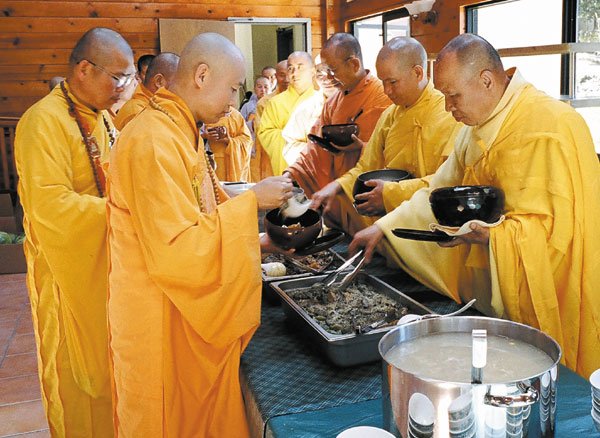To Buddhist Master Th
ích Tinh Tu and his pupils, the mind is the center of life
The call to wakefulness sounds like a visit from the ice cream man.
At 5am a small bell peals through a modest village of squat, simple houses, summoning the residents of Kim-Son Meditation Center to the morning chant. The monks and nuns move in silence. When the bell stops ringing in
the pre- dawn darkness, the only signs of life are the lights of Watsonville and a lone ship in Monterey Bay, twinkling far below.
An hour ago, Master Thích Tinh Tu arose, exercised for 40 minutes, and showered before slipping into his orange and yellow robes. As he begins his daily meditation, his students prepare for the day, assembling in the meditation room as the sun rises above Mount Madonna.
The leader strikes a gong, and so begins a series of chants that will last an hour. Today’s prayers are to the Medicine Buddha, the healer of spiritual, emotional and, some believe, physical wounds.
The prayer room is a converted living room, dressed in drab yellow except for the altar, which is anchored by a large gold Buddha and covered with pillows, red roses, and yellow and burgundy orchids.
Those who pray sit cross-legged and slightly hunched on stiff brown cushions.
One by one, they break from their poses. They look as if they are practicing yoga as they rise and bow deeply four times to the Buddha, each leaving the group to pad off with a clear mind to the large hall where they will share breakfast with Master Tu.
“We have to be aware of what we are doing in the present moment,” said monk Quang Tri. “The important thing is to not let our thoughts go like a monkey, just go from one thing to another. We practice sending compassion into all the organs in our body. You wake the compassion and send it to your anger. It’s like hugging your negative thoughts.”
Breakfast is at 8am. Visitors to the monastery are always welcome to share the generous spread of fried rice, oatmeal, fruit and toast. There is no meat, but there are Fruit Loops and Cheerios.
The large hall has room enough to feed hundreds of guests on retreat weekends. More than 10,000 visitors came to mark the Tet Festival, the celebration of the Vietnamese New Year, in early February. For a day, traffic was backed up four miles from the Summit Road monastery to Hecker Pass at the mouth of Mount Madonna County Park.
But on a normal Wednesday morning, the only diners are the two dozen monks and nuns, and a handful of lay people and trainees. The room resembles an empty mess hall. Master Tu sits alone at a small table at the head of the room. His pupils sit according to their rank: the monks at an arm’s length, the nuns further down the main table. Trainees and visitors sit at the outer tables.
“The monastery system is very similar to the military, by the rank,” Quang said. “Those who come first have more priority. It’s very formal. People sit to show respect for the master.”
No one talks during the meal. Master Tu strikes a gong at his table. It’s a reminder to take a deep breath, to be with oneself in the moment. It is a bell for mindfulness. Only when they finish their meals do the monks talk among themselves and to their master. Mealtimes are another opportunity to practice meditation.
“I don’t do many things at the same time,” said Master Tu, who became a monk when he was 14. “When I eat, I know I am eating. When I talk with you, I know I am talking. Focusing the mind on what you are doing is very important.”
After breakfast, the monks go on a meditation walk. They walk after every meal. Master Tu often walks alone, followed by the mongrel, Minh Yen, and a wolf, Lily.
“He knows how to meditate,” Master Tu said, pointing to the mongrel. “He’s very happy.”
Master Tu’s monastery sits on 35 acres of woodlands. Since he bought the land in 1983, he has carved out hiking paths over the grounds. His morning walk lasts an hour, and every moment is an opportunity for him to teach.
Pointing to bamboo stalks shooting out of the ground, he said, “I love bamboo. It is empty inside. Sometimes if you have an empty mind, you feel better. In Buddhism, we have an empty heart. If you keep your mind and heart empty, it is easy to put something in, like a garden. If you prepare your garden and take care of the soil, the flower comes out very fast and beautiful. When you have an empty mind, it’s easy to listen to someone.”
He stops in front of a towering Happy Buddha that greets visitors. The huge stone statue, like dozens of others on the grounds, was flown in from Vietnam. Happy Buddha wears a broad, joyful smile. Crawling on him are six baby Buddhas, symbolizing the senses: sight, sound, smell, taste, touch and the mind.
“If you control your six senses, and know how to look carefully, you can take out your sufferings,” Master Tu said. “You look at him smile when you come up here, you remind yourself, just smile.”
Master Tu’s instruction is targeted at releasing the anger that rules people’s lives, he said. In addition to the monks and nuns living at the monastery, he administers to visitors, offering relationship counseling and life advice. He has churches all over Northern California and a monastery in Mobile, Ala.
“I don’t know much, but I do know how to make good relationships,” he said. “Buddhism is the peaceful religion. We don’t make any reason for war or for fighting.”
But even practiced Buddhists struggle with feelings of anger and desire, he said, and some are unable to let go of what the master calls the seed of anger.
“If you don’t have the seed of anger in your mind, then how can you get angry?” he said. “If you didn’t study English before, how can you speak English now?”
People who hold onto their beliefs, he said, cannot see anything new, they cannot listen. The whole world is created in one’s mind. The mind is a place in itself. The mind is the only place. The Buddha taught that the root of suffering is in blind desire, anger and ignorance.
“Buddha said, ‘The mind can make a heaven of hell and a hell of heaven,'” Master Tu said. “We are the result of our thinking. Our character is built by our thinking.”
When his walk is over, the master returns to his rooms, where he will await visitors and prepare his afternoon teachings. The monks and nuns apply themselves to chores around the monastery. When they hear a gong, they remind themselves to breath deeply and live in the present moment, every task a step toward enlightenment.
A Brief Explanation of Buddhism
The Buddha was born in Nepal about 2,600 years ago, the son of the ruler of the Sakya clan. The legend of the Buddha holds that he married and had a child, but upon leaving his family’s enclave he saw firsthand the suffering of the people in his country. He devoted his life to an ascetic existence in which suffering is curtailed not through physical comforts, but the cultivation of the mind.
The basic tenets of Buddhism are karma, the notion that actions, good or bad, come back to the doer; dharma, the way to practice; and sangha, following the teachings of a master in a communal setting.
Thích Tinh Tu, master of the Kim-Son Meditation Center atop Mount Madonna, teaches that the mind is the center of life, and the world we live in is created and controlled there.
“If you know how to cultivate the mind, you know how to be,” Master Tu says. “If you know how to cultivate wisdom, you can see the way for living.”
Master Tu’s teachings are centered in thoughts and actions that forge strong relationships and bring happiness to others.
“We are the result of our thinking. Anyone who acts or speaks with an evil heart, sorrow follows him or her like a shadow,” the master says. “Anyone who acts or speaks with a peaceful heart, happiness follows him or her like walking in the sunlight.”
Source: Kim-Son Meditation Center













